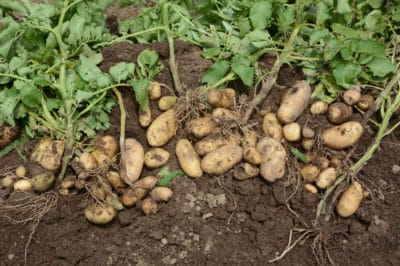Potato-Growing Basics
Potatoes grow best in a rich, loose, friable soil that is on the acidic side. However, acidic soils often don’t release nutrients as well, so a good fertilizer program is important. Keep weeds down to prevent competition for water and nutrients. Water well during the growing period so the soil stays slightly damp at all times. Don’t over-water, however, as it encourages fungal diseases.
Climate and Harvest
Potatoes can be grown in any USDA Zone as long as you time planting and harvest properly. The plants are susceptible to frost, but tubers can handle cold soil as long as it doesn’t freeze. In very cold climates, you’ll probably be harvesting in late summer, while gardeners in warmer areas may have several harvest periods with the last in late fall.
How the Variety Affects Harvest
You can find hundreds of potato varieties, but all fall into early, mid-season or late harvest categories. These include:
- All Blue – late
- Banana – mid-season
- Centennial Russet – late
- French Fingerling – mid-season
- German Butterball – late
- Kerr’s Pink – midseason
- Sangre – mid-season
- Snowden – late
- Viking Red – early
- Yellow Finn – early
- Yukon Gold – early.
Soil and Harvest
The quality of your soil has an impact on the size and health of your crop, but it also affects harvest. A heavy clay soil is often rich in nutrients, but it is more difficult to dig in such soils than sandy loams. Clay soil is also more likely to retain water and may not be dry enough for harvesting in wet areas. However, soil that is high in sand needs lots of humus to provide the proper texture and make it easier to dig.
Watering and Harvest
Potatoes need and use a lot of water during the growing season and through the flowering period. However, once the tops begin to die down, you should withhold water in humid climates. In arid regions, cut the water by about half. This forces all nutrients and water into the developing tubers. Once you’re ready to harvest, you may need to water a day or two before just to loosen the soil.
Tools For Harvesting
Depending on how many potatoes they’re dealing with, gardeners may use their hands, a trowel, a shovel or a potato fork to harvest. In soft soil and with a small crop, gloved hands or a trowel often work well. A pointed-end shovel will work for harvesting potatoes but the risk of cutting them with the sharp edge is high. A three- or four-tined potato fork is usually the ideal tool.
Harvesting Techniques
Always handle potatoes gently when harvesting. Bruises can lead to rot and loss of a potato. If you happen to cut or drop a potato, set it aside to eat as soon as possible. After you’ve harvested a plant or two, you’ll be able to determine the level at which the tubers are found. Place your shovel or fork well below this level and lever up the plant.
Weather and Harvesting
It’s best to plan your potato harvest when the weather is expected to be dry for several days. A warm dry day after a period of at least a week with no rain is ideal. Harvesting on a cloudy day is also a good choice, as potatoes exposed to light turn green and develop solanine, which makes them inedible. Weather conditions are particularly important in the case of late potatoes which are meant for long storage.
When to Harvest
New potatoes can be harvested from any variety – they are simply smaller, less mature potatoes. Use them within a day or two as they will not keep well. Harvest new potatoes about two or three weeks after flowering. Plan your main crop harvest according to the expected maturity date. However, once the tops start to die down, you can expect to harvest within three to four weeks.
Curing Potatoes
Your potatoes must be properly cured after harvest. Don’t wash them as moisture increase the risk of rot and fungal problems in storage. You can gently brush off clumps of dirt. Place the potatoes where they will have good air circulation and be out of the sun, such as an open shed or garage. Cure for about two weeks, then place in storage.
